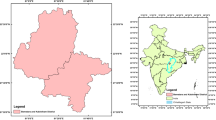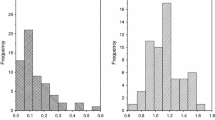Abstract.
A theoretical model to estimate the gamma-radiation dose rates inside a room is reviewed, refined and applied. The scheme of the model is based on the relative effects of the different room elements that control the amount of radiation. The relative dose rates are simulated by the MCNP5 software. The studied gamma radiation is the one due to the two radioactive decay series 238U and 232Th, and the radionuclide 40K. The affecting elements considered are the widths of the parts of the room, the density of the construction material, the lengths and heights of the different parts of the room, radiation from neighboring rooms, the uncertainty in the equilibrium of the 238U series. The effects of the existence of a gap inside some of the walls and the existence of partial walls, windows and doors are also studied. The model is applied through an example that includes all the enrolled factors.
Similar content being viewed by others
References
J.G. Ackers, J.F. Den Boer, P. De Jong, R.A. Wolschrijn, Sci. Total Environ. 45, 151 (1985)
J.A. Ademola, I.P. Farai, Radiat. Prot. Dosim. 114, 524 (2005)
N. Ahmad, A.J.A. Hussein, Aslam, J. Environ. Radioact. 41, 127 (1998)
P. De Jong, W. Van Dijk, H.P. Burger, ${}^{226}$Ra and ${}^{228}$Ra concentrations in gypsum plasters and mortars used in the Netherlands, in Proceedings of the Second International Symposium on Naturally Occurring Radioactive Materials (NORM II), Nov. 10-13, 1998, Krefeld, Germany (ENA, 1998) pp. 58--61
L. Koblinger, Health Phys. 34, 459 (1978)
M.F. Máduar, G. Hiromoto, Radiat. Prot. Dosim. 111, 221 (2004)
A. Malanca, V. Pessina, G. Dallara, Braz. Radiat. Prot. Dosim. 48, 199 (1993)
R. Mustonen, Radiat. Prot. Dosim. 7, 235 (1984)
R.S. O’Brien, Health Phys. 72, 92 (1997)
I. Othman, M. Mahrouka, Radiat. Prot. Dosim. 55, 299 (1994)
E. Stranden, Phys. Med. Biol. 24, 921 (1979)
Enhanced radioactivity of building materials, Radiation Protection 96 (European Commission, Luxembourg, 1999)
Radiological protection principles concerning the natural radioactivity of building materials, Radiation Protection 112 (European Commission, Luxembourg, 1999)
Commission recommendation 90/143/Euratom of 21 February 1990 on the protection of the public against indoor exposure to radon. Off, J. Eur. Commun. L80 (European Communities, Luxembourg, 1990)
J.S. Puskin, Health Phys. 84, 526 (2003)
B.L. Cohen, Health Phys. 68, 157 (1995)
M. Al-Zoughool, D. Krewski, Int. J. Radiat. Biol. 85, 57 (2009)
MCNP - a general Monte Carlo N-Particle transport software, version 5 (Los Alamos National Laboratory, Los Alamos, 2005)
M. Orabi, J. Environ. Radioact. 165, 54 (2016)
M. Orabi, Radiat. Phys. Chem. 147, 114 (2018)
M. Orabi, Health Phys. 112, 294 (2017)
G. Keller, B. Hoffmann, T. Feigenspan, Sci. Total Environ. 272, 85 (2001)
K. Kovler, A. Perevalov, V. Steiner, E. Rabkin, Health Phys. 86, 505 (2004)
N.M. Mirza, B. Ali, S.M. Mirza, M. Tufail, N. Ahmad, Radiat. Prot. Dosim. 38, 307 (1991)
M.M. Sherif, M. Orabi, S.Y. Abdo, Gamma radiation dose assessment in Yemeni buildings, in Proceedings of the XX International Scientific Conference of Young Scientists and Specialists (AYSS-2016), JINR, Dubna, Russia, 2016 (INDICO, 2017) p. 290
J.H. Hubbell, S.M. Seltzer, Tables of X-ray mass attenuation coefficients and mass energy-absorption coefficients 1keV to 20MeV for elements $Z=1$ to 92 and 48 additional substances of dosimetric interest, Report PB95-220539 (National Institute of Standards and Technology, Gaithersburg, 1995)
UNSCEAR: United Nations Scientific Committee on the Effects of Atomic Radiations sources, effects and risks of ionizing radiation (United Nations, New York, 2000)
S. Stoulos, M. Manolopoulou, C. Papastefanou, J. Environ. Radioact. 69, 225 (2003)
P. Ujic, I. Celikovic, A. Kandic, I. Vukanac, M. Durasevic, D. Dragosavac, Z. Zunic, Appl. Radiat. Isotopes 68, 201 (2010)
Author information
Authors and Affiliations
Corresponding author
Additional information
Publisher’s Note
The EPJ Publishers remain neutral with regard to jurisdictional claims in published maps and institutional affiliations.
Rights and permissions
About this article
Cite this article
Orabi, M. Modeling the indoor gamma-radiation dose: A review of refinements and application. Eur. Phys. J. Plus 134, 290 (2019). https://doi.org/10.1140/epjp/i2019-12649-3
Received:
Accepted:
Published:
DOI: https://doi.org/10.1140/epjp/i2019-12649-3




